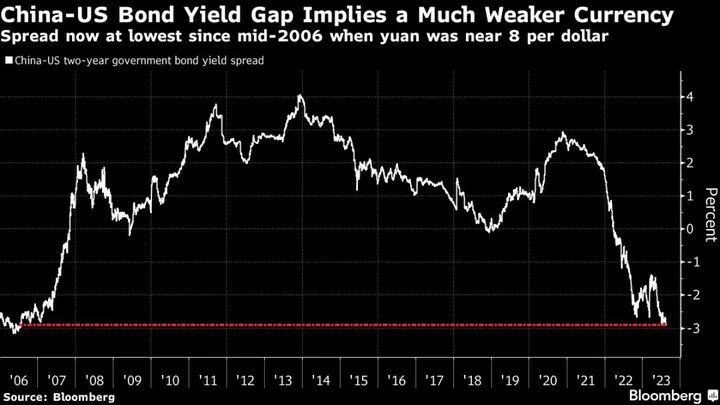While Beijing moves to stabilize the yuan, Wall Street still sees plenty of room for the Chinese currency to fall.
After the offshore yuan weakened last week past 7.30 per dollar, just a stone’s throw from last year’s all-time low, the People’s Bank of China pushed back, with verbal warnings, urging dollar sales and following up with the biggest daily reference rate bias on record for the managed currency.
While that appears to have slowed the momentum of the selloff, along with a welcome bout of broad dollar weakness, strategists say these stopgap measures aren’t enough to halt the yuan’s depreciation — a trend shaped by a weak economy and relatively low yields. Rate cuts have only widened the yield gap with the US, and the lack of any significant steps to boost consumer spending and a spreading crisis in the property sector further undermine investor confidence.
“The fundamental case for additional yuan weakness remains very much intact,” JPMorgan Chase & Co. analysts led by Meera Chandan, co-head of foreign exchange in London, wrote in a research report on Friday. “We see the dollar-yuan uptrend as durable, but recent events are a reminder that authorities will periodically try to disrupt one way moves.”
On Monday, funding costs in the offshore yuan market soared by the most in six years amid speculation that authorities are making it more expensive to bet against the currency.
Yuan Shorts Squeezed as Funding Costs Jump to a Five-Year High
The problem is, Chinese interest rates remain well below their US counterparts across tenors. Two-year Treasuries now yield about 290 basis points above Chinese government bonds of the same maturity, a level last seen in mid-2006.
While the offshore yuan only started trading in 2010, the comparable onshore currency at the time was trading near 8 per dollar. That would imply a roughly 9% downside for the Chinese currency if the yield gap is sustained, without allowing for other factors.
“We don’t think there is a hard line-in-the-sand for the exchange rate,” said Ju Wang, head of greater China FX & rates strategy at BNP Paribas in Hong Kong. “Ultimately it depends on the yield difference between US and China, and we’re witnessing a nearly record widening of nominal rates differential.”
China’s central bank vowed to “step up macroeconomic policy adjustment” in its quarterly monetary report published on Thursday, reaffirming its accommodative policy stance. It also pledged to resolutely prevent excessive movements in the exchange rate.
The offshore yuan traded at 7.2870 per dollar Tuesday, not too far from the all-time low of 7.3749 reached in October. Earlier this year, it was trading around 6.70 amid hopes economic reopening would spur a recovery in the world’s second-largest economy.
Christopher Wong, an FX strategist at OCBC in Singapore, said the market is closely watching whether “dollar-yuan will rise further to test the 7.38-41 resistance area.”
If that happens, it “may push markets to try and test higher possibly toward 7.50 within weeks,” Wong said.
To Craig Chan, Global Head of FX Strategy at Nomura Singapore Ltd., the persistent gap between the yuan’s daily fixing and market expectations may have already begun to undermine the stabilizing effect of the reference rate. Authorities may be forced to sell dollars if the gap approaches the 2% daily band, Chan noted.
In its biggest pushback against a weaker yuan via the so-called daily fixing, the PBOC set the rate for the managed currency about 1.5% stronger than the average estimate in a Bloomberg survey with traders and analysts.
“Regarding yuan depreciation, our conviction level is at a maximum 5 out of 5,” Chan said, adding dollar-yuan could possibly reach 7.50 and beyond. The biggest risk for beating on yuan weakness is a significant economic stimulus package out of Beijing, he said.
Still, the weakening yuan does come with some benefits for China, offering a leg up as the country battles deflation in stark contrast to many Group-of-10 economies.
“China needs to lower real rates right now,” Geoffrey Yu, senior strategist at BNY Mellon, said in an interview last week on Bloomberg Television. “That’s why they’re allowing the renminbi to depreciate, so they can import some inflation.”
--With assistance from Tania Chen and Iris Ouyang.
(Updates yuan level and OCBC comment)

